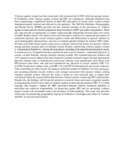Please use this identifier to cite or link to this item:
https://cris.library.msu.ac.zw//handle/11408/1176| Title: | The association between violence against women and HIV: evidence from a national population-based survey in Zimbabwe | Authors: | Nyamayemombe, C. Mishra, V. Rusakaniko, S. Benedikt, C. Gwazane, M. Mukweza, P. |
Keywords: | Violence against women, Intimate partner violence (IPV), Spousal violence, Domestic violence, HIV, Zimbabwe | Issue Date: | Feb-2010 | Publisher: | United Nations Population Fund (UNFPA) | Series/Report no.: | Zimbabwe Working Papers; | Abstract: | Violence against women has been associated with increased risk of HIV infection among women. In Zimbabwe, both violence against women and HIV are widespread. Although Zimbabwe has been experiencing a significant decline of adult HIV prevalence in recent years, women remain disproportionately infected and affected by the epidemic. The 2005-06 Zimbabwe Demographic and Health Survey (ZDHS) provides the first national estimate of the prevalence of violence against women and also the first population-based estimates of HIV prevalence and patterns. These new data provide an opportunity to further understand the relationship between these two issues of public health concern. Our analysis first used descriptive statistics to examine the prevalence of emotional, physical, and sexual violence against women and differentials in spousal violence by socio-demographic characteristics, and also to compare spousal violence by women’s HIV status. We then used multivariate logistic regression to examine selected risk factors for spousal violence among currently married and ever-married women. Results confirm that violence against women is widespread in Zimbabwe. Among all respondents, including both married and unmarried, nearly 6 women in every 10 reported having experienced some type of violence—emotional, physical, or sexual—in their lifetime. Among currently married women, 28% reported physical violence and 18 % reported sexual violence from their husband. Currently married women who had experienced physical violence only, or both physical and sexual violence, were significantly more likely to be HIV-positive than those who had not experienced any physical or sexual violence (OR 1.35, p=0.020 for physical violence only; and OR 1.38, p=0.029 for both physical and sexual violence). After controlling for other factors, the analysis found that number of children ever born, polygyny, and accepting attitudes toward violence were strongly associated with spousal violence among currently married women. Because the study is based on cross-sectional data, it cannot draw conclusions about the causal relationship between violence against women and HIV transmission. Despite this, the findings call for special attention to societal values and norms on gender equality in programming, both for prevention of violence against women and prevention of HIV. It is within marriage that women’s options for HIV prevention become limited. Increased attention to individual and collective responsibility for protecting against HIV and for preventing violence against women will sustainably reduce the incidence of both problems. This study also provides useful data for prioritizing geographical regions in Zimbabwe with higher prevalence of violence and HIV for focused interventions. | URI: | http://hdl.handle.net/11408/1176 |
| Appears in Collections: | Research Papers |
Files in This Item:
| File | Description | Size | Format | |
|---|---|---|---|---|
| The Association between.pdf | Abstract | 108.51 kB | Adobe PDF |  View/Open |
Page view(s)
124
checked on Oct 9, 2025
Download(s)
30
checked on Oct 9, 2025
Google ScholarTM
Check
Items in MSUIR are protected by copyright, with all rights reserved, unless otherwise indicated.



